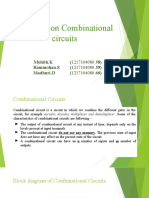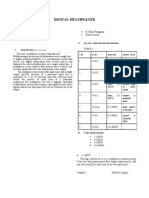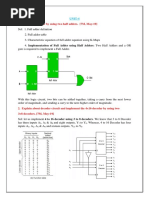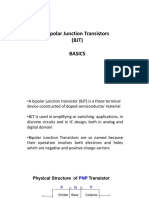Bolean Implementation Using Mux
Uploaded by
abhishek kolseBolean Implementation Using Mux
Uploaded by
abhishek kolseROHINI COLLEGE OF ENGINEERING AND TECHNOLOGY
EC 8392 – DIGITAL ELECTRONICS
UNIT – II : COMBINATIONAL CIRCUIT DESIGN
MULTIPLEXER: (Data Selector)
A multiplexer or MUX, is a combinational circuit with more than one input line, one
output line and more than one selection line. A multiplexer selects binary information
present from one of many input lines, depending upon the logic status of the selection
inputs, and routes it to the output line. Normally, there are 2n input lines and n
selection lines whose bit combinations determine which input is selected. The
multiplexer is often labeled as MUX in block diagrams.
A multiplexer is also called a data selector, since it selects one of many inputs and
steers the binary information to the output line.
Fig : 2.30 - Block diagram of Multiplexer
2-to-1- line Multiplexer:
The circuit has two data input lines, one output line and one selection line, S.
When S= 0, the upper AND gate is enabled and I0 has a path to the output.
When S=1, the lower AND gate is enabled and I1 has a path to the output.
EC 8392 – DIGITAL ELECTRONICS
ROHINI COLLEGE OF ENGINEERING AND TECHNOLOGY
Fig : 2.31 - Logic diagram
The multiplexer acts like an electronic switch that selects one of the two sources.
Truth table:
S Y
0 I0
1 I1
4-to-1-line Multiplexer:
A 4-to-1-line multiplexer has four (2n) input lines, two (n) select lines and one output
line. It is the multiplexer consisting of four input channels and information of one of the
channels can be selected and transmitted to an output line according to the select
inputs combinations. Selection of one of the four input channel is possible by two
selection inputs.
Each of the four inputs I0 through I3, is applied to one input of AND gate. Selection lines
S1 and S0 are decoded to select a particular AND gate. The outputs of the AND gate are
applied to a single OR gate that provides the 1-line output.
EC 8392 – DIGITAL ELECTRONICS
ROHINI COLLEGE OF ENGINEERING AND TECHNOLOGY
Fig : 2.32 - 4-to-1-Line Multiplexer
Function table:
S1 S0 Y
0 0 I0
0 1 I1
1 0 I2
1 1 I3
To demonstrate the circuit operation, consider the case when S1S0= 10. The AND gate
associated with input I2 has two of its inputs equal to 1 and the third input connected to
I2. The other three AND gates have atleast one input equal to 0, which makes their
outputs equal to 0. The OR output is now equal to the value of I2, providing a path from
the selected input to the output.
EC 8392 – DIGITAL ELECTRONICS
ROHINI COLLEGE OF ENGINEERING AND TECHNOLOGY
The data output is equal to I0 only if S1= 0 and S0= 0; Y= I0S1‘S0‘. The
data output is equal to I1 only if S1= 0 and S0= 1; Y= I1S1‘S0.
The data output is equal to I2 only if S1= 1 and S0= 0; Y= I2S1S0‘.
The data output is equal to I3 only if S1= 1 and S0= 1; Y= I3S1S0. When these
terms are ORed, the total expression for the data output is,
Y= I0S1’S0’+ I1S1’S0 +I2S1S0’+ I3S1S0.
As in decoder, multiplexers may have an enable input to control the operation of the
unit. When the enable input is in the inactive state, the outputs are disabled, and when
it is in the active state, the circuit functions as a normal multiplexer.
Quadruple 2-to-1 Line Multiplexer:
This circuit has four multiplexers, each capable of selecting one of two input lines.
Output Y0 can be selected to come from either A0 or B0. Similarly, output Y1 may have
the value of A1 or B1, and so on. Input selection line, S selects one of the lines in each
of the four multiplexers. The enable input E must be active for normal operation.
Although the circuit contains four 2-to-1-Line multiplexers, it is viewed as a circuit that
selects one of two 4-bit sets of data lines. The unit is enabled when E= 0. Then if S= 0,
the four A inputs have a path to the four outputs. On the other hand, if
S=1, the four B inputs are applied to the outputs. The outputs have all 0‘s when E= 1,
regardless of the value of S.
EC 8392 – DIGITAL ELECTRONICS
ROHINI COLLEGE OF ENGINEERING AND TECHNOLOGY
Fig : 2.33 – Quadruple 2 to 1 MUX
Application:
The multiplexer is a very useful MSI function and has various ranges of applications in
data communication. Signal routing and data communication are the important
applications of a multiplexer. It is used for connecting two or more sources to guide to
a single destination among computer units and it is useful for constructing a common
EC 8392 – DIGITAL ELECTRONICS
ROHINI COLLEGE OF ENGINEERING AND TECHNOLOGY
bus system. One of the general properties of a multiplexer is that Boolean functions
can be implemented by this device.
Implementation of Boolean Function using MUX:
Any Boolean or logical expression can be easily implemented using a multiplexer. If a
Boolean expression has (n+1) variables, then ‗n‘ of these variables can be connected to
the select lines of the multiplexer. The remaining single variable along with constants 1
and 0 is used as the input of the multiplexer. For example, if C is the single variable,
then the inputs of the multiplexers are C, C‘, 1 and 0. By this method any logical
expression can be implemented.
In general, a Boolean expression of (n+1) variables can be implemented using a
multiplexer with 2n inputs.
1. Implement the following boolean function using 4: 1
multiplexer,
F (A, B, C) = ∑m (1, 3, 5, 6). Solution:
Variables, n= 3 (A, B, C) Select lines= n-
1 = 2 (S1, S0) 2n-1 to MUX i.e., 22 to 1 = 4
to 1 MUX
Input lines= 2n-1 = 22 = 4 (D0, D1, D2, D3)
Implementation table:
Apply variables A and B to the select lines. The procedures for implementing the
function are:
i. List the input of the multiplexer
EC 8392 – DIGITAL ELECTRONICS
ROHINI COLLEGE OF ENGINEERING AND TECHNOLOGY
ii. List under them all the minterms in two rows as shown below.
The first half of the minterms is associated with A‘ and the second half with A. The
given function is implemented by circling the minterms of the function and applying the
following rules to find the values for the inputs of the multiplexer.
1. If both the minterms in the column are not circled, apply 0 to the corresponding
input.
2. If both the minterms in the column are circled, apply 1 to the corresponding
input.
3. If the bottom minterm is circled and the top is not circled, apply C to the input.
4.If the top minterm is circled and the bottom is not circled, apply C‘ to the input.
Multiplexer Implementation:
EC 8392 – DIGITAL ELECTRONICS
ROHINI COLLEGE OF ENGINEERING AND TECHNOLOGY
2. F (x, y, z) = ∑m (1, 2, 6, 7) Solution:
Implementation table:
Multiplexer Implementation:
3. F ( A, B, C) = ∑m (1, 2, 4, 5) Solution:
Variables, n= 3 (A, B, C) Select lines= n-
1 = 2 (S1, S0) 2n-1 to MUX i.e., 22 to 1 = 4
to 1 MUX
Input lines= 2n-1 = 22 = 4 (D0, D1, D2, D3) Implementation
table:
EC 8392 – DIGITAL ELECTRONICS
ROHINI COLLEGE OF ENGINEERING AND TECHNOLOGY
Multiplexer Implementation:
4. F( P, Q, R, S)= ∑m (0, 1, 3, 4, 8, 9, 15)
Solution:
Variables, n= 4 (P, Q, R, S) Select
lines= n-1 = 3 (S2, S1, S0)
2n-1 to MUX i.e., 23 to 1 = 8 to 1 MUX
Input lines= 2n-1 = 23 = 8 (D0, D1, D2, D3, D4, D5, D6, D7)
EC 8392 – DIGITAL ELECTRONICS
ROHINI COLLEGE OF ENGINEERING AND TECHNOLOGY
Implementation table:
Multiplexer Implementation:
5. Implement the Boolean function using 8: 1 and also using 4:1
multiplexer F (A, B, C, D) = ∑m (0, 1, 2, 4, 6, 9, 12, 14)
EC 8392 – DIGITAL ELECTRONICS
ROHINI COLLEGE OF ENGINEERING AND TECHNOLOGY
Solution:
Variables, n= 4 (A, B, C, D) Select
lines= n-1 = 3 (S2, S1, S0)
2n-1 to MUX i.e., 23 to 1 = 8 to 1 MUX
Input lines= 2n-1 = 23 = 8 (D0, D1, D2, D3, D4, D5, D6, D7)
Implementation table:
Multiplexer Implementation (Using 8: 1 MUX):
EC 8392 – DIGITAL ELECTRONICS
ROHINI COLLEGE OF ENGINEERING AND TECHNOLOGY
Using 4: 1 MUX:
6. F (A, B, C, D) = ∑m (1, 3, 4, 11, 12, 13, 14, 15)
Solution:
Variables, n= 4 (A, B, C, D) Select
lines= n-1 = 3 (S2, S1, S0)
2n-1 to MUX i.e., 23 to 1 = 8 to 1 MUX
Input lines= 2n-1 = 23 = 8 (D0, D1, D2, D3, D4, D5, D6, D7)
EC 8392 – DIGITAL ELECTRONICS
ROHINI COLLEGE OF ENGINEERING AND TECHNOLOGY
Implementation table:
Multiplexer Implementation:
7. Implement the Boolean function using 8: 1 multiplexer.
F (A, B, C, D) = A’BD’ + ACD + B’CD + A’C’D.
Solution:
EC 8392 – DIGITAL ELECTRONICS
ROHINI COLLEGE OF ENGINEERING AND TECHNOLOGY
Convert into standard SOP form,
= A‘BD‘ (C‘+C) + ACD (B‘+B) + B‘CD (A‘+A) + A‘C‘D (B‘+B)
= A‘BC‘D‘ + A‘BCD‘+ AB‘CD+ ABCD +A‘B‘CD + AB‘CD+A‘B‘C‘D+ A‘BC‘D
= A‘BC‘D‘ + A‘BCD‘+ AB‘CD + ABCD +A‘B‘CD +A‘B‘C‘D+ A‘BC‘D
= m4+ m6+ m11+ m15+ m3+ m1+ m5
= ∑m (1, 3, 4, 5, 6, 11, 15)
Implementation table:
Multiplexer Implementation:
EC 8392 – DIGITAL ELECTRONICS
ROHINI COLLEGE OF ENGINEERING AND TECHNOLOGY
8. Implement the Boolean function using 8: 1 multiplexer.
F (A, B, C, D) = AB’D + A’C’D + B’CD’ + AC’D.
Solution:
Convert into standard SOP form,
= AB‘D (C‘+C) + A‘C‘D (B‘+B) + B‘CD‘ (A‘+A) + AC‘D (B‘+B)
= AB‘C‘D+ AB‘CD+ A‘B‘C‘D + A‘BC‘D +A‘B‘CD‘ + AB‘CD‘ +AB‘C‘D+ ABC‘D= AB‘C‘D
+ AB‘CD+ A‘B‘C‘D + A‘BC‘D +A‘B‘CD‘ + AB‘CD‘+ ABC‘D = m9+ m11+ m1+ m5+
m2+ m10+ m13
= ∑m (1, 2, 5, 9, 10, 11, 13).
Implementation Table:
EC 8392 – DIGITAL ELECTRONICS
ROHINI COLLEGE OF ENGINEERING AND TECHNOLOGY
Multiplexer Implementation:
9. Implement the Boolean function using 8: 1 and also using 4:1 multiplexer F (w, x, y,
z) = ∑m (1, 2, 3, 6, 7, 8, 11, 12, 14)
Solution:
Variables, n= 4 (w, x, y, z)
Select lines= n-1 = 3 (S2, S1, S0)
2n-1 to MUX i.e., 23 to 1 = 8 to 1 MUX
Input lines= 2n-1 = 23 = 8 (D0, D1, D2, D3, D4, D5, D6, D7)
EC 8392 – DIGITAL ELECTRONICS
ROHINI COLLEGE OF ENGINEERING AND TECHNOLOGY
Implementation table:
Multiplexer Implementation (Using 8:1 MUX):
EC 8392 – DIGITAL ELECTRONICS
ROHINI COLLEGE OF ENGINEERING AND TECHNOLOGY
(Using 4:1 MUX):
10. Implement the Boolean function using 8: 1 multiplexer
F (A, B, C, D) = ∏m (0, 3, 5, 8, 9, 10, 12, 14) Solution:
Variables, n= 4 (A, B, C, D) Select
lines= n-1 = 3 (S2, S1, S0)
2n-1 to MUX i.e., 23 to 1 = 8 to 1 MUX
Input lines= 2n-1 = 23 = 8 (D0, D1, D2, D3, D4, D5, D6, D7)
EC 8392 – DIGITAL ELECTRONICS
ROHINI COLLEGE OF ENGINEERING AND TECHNOLOGY
Implementation table:
Multiplexer Implementation:
EC 8392 – DIGITAL ELECTRONICS
ROHINI COLLEGE OF ENGINEERING AND TECHNOLOGY
11. Implement the Boolean function using 8: 1 multiplexer
F (A, B, C, D) = ∑m (0, 2, 6, 10, 11, 12, 13) + d (3, 8, 14)
Solution:
Variables, n= 4 (A, B, C, D) Select
lines= n-1 = 3 (S2, S1, S0)
2n-1 to MUX i.e., 23 to 1 = 8 to 1 MUX
Input lines= 2n-1 = 23 = 8 (D0, D1, D2, D3, D4, D5, D6, D7) Implementation
Table:
Multiplexer Implementation:
EC 8392 – DIGITAL ELECTRONICS
ROHINI COLLEGE OF ENGINEERING AND TECHNOLOGY
12. An 8×1 multiplexer has inputs A, B and C connected to the selection inputs S2, S1,
and S0 respectively. The data inputs I0 to I7 are as follows I1=I2=I7= 0; I3=I5= 1; I0=I4= D
and I6= D'.
Determine the Boolean function that the multiplexer implements.
Multiplexer Implementation:
Implementation table:
F (A, B, C, D) = ∑m (3, 5, 6, 8, 11, 12, 13).
EC 8392 – DIGITAL ELECTRONICS
ROHINI COLLEGE OF ENGINEERING AND TECHNOLOGY
DEMULTIPLEXER:
Demultiplex means one into many. Demultiplexing is the process of taking information
from one input and transmitting the same over one of several outputs.
A demultiplexer is a combinational logic circuit that receives information on a single
input and transmits the same information over one of several (2n) output lines.
Fig : 2.34 - Block diagram of demultiplexer
The block diagram of a demultiplexer which is opposite to a multiplexer in its operation
is shown above. The circuit has one input signal, ‗n‘ select signals and 2n output signals.
The select inputs determine to which output the data input will be connected. As the
serial data is changed to parallel data, i.e., the input caused to appear on one of the n
output lines, the demultiplexer is also called a ―data distributer‖ or a ―serial-to-
parallel converter‖ .
EC 8392 – DIGITAL ELECTRONICS
ROHINI COLLEGE OF ENGINEERING AND TECHNOLOGY
1-to-4 Demultiplexer:
A 1-to-4 demultiplexer has a single input, Din, four outputs (Y0 to Y3) and two select
inputs (S1 and S0).
Fig : 2.35 - Logic Symbol
The input variable Din has a path to all four outputs, but the input information is
directed to only one of the output lines. The truth table of the 1-to-4 demultiplexer is
shown below.
Enable S1 S0 Din Y0 Y1 Y2 Y3
0 x x x 0 0 0 0
1 0 0 0 0 0 0 0
1 0 0 1 1 0 0 0
1 0 1 0 0 0 0 0
1 0 1 1 0 1 0 0
1 1 0 0 0 0 0 0
1 1 0 1 0 0 1 0
EC 8392 – DIGITAL ELECTRONICS
ROHINI COLLEGE OF ENGINEERING AND TECHNOLOGY
1 1 1 0 0 0 0 0
1 1 1 1 0 0 0 1
Truth table of 1-to-4 demultiplexer
From the truth table, it is clear that the data input, Din is connected to the output
Y0, when S1= 0 and S0= 0 and the data input is connected to output Y1 when S1= 0 and
S0= 1. Similarly, the data input is connected to output Y2 and Y3 when S1= 1 and S0= 0
and when S1= 1 and S0= 1, respectively. Also, from the truth table, the expression for
outputs can be written as follows,
Y0= S1’S0’Din
Y1= S1’S0Din
Y2= S1S0’Din
Y3= S1S0Din
EC 8392 – DIGITAL ELECTRONICS
ROHINI COLLEGE OF ENGINEERING AND TECHNOLOGY
Fig : 2.36 - Logic diagram of 1-to-4 demultiplexer
Now, using the above expressions, a 1-to-4 demultiplexer can be implemented using
four 3-input AND gates and two NOT gates. Here, the input data line Din, is connected
to all the AND gates. The two select lines S1, S0 enable only one gate at a time and the
data that appears on the input line passes through the selected gate to the associated
output line.
1-to-8 Demultiplexer:
A 1-to-8 demultiplexer has a single input, Din, eight outputs (Y0 to Y7) and three
select inputs (S2, S1 and S0). It distributes one input line to eight output lines based on
the select inputs. The truth table of 1-to-8 demultiplexer is shown below.
EC 8392 – DIGITAL ELECTRONICS
ROHINI COLLEGE OF ENGINEERING AND TECHNOLOGY
Din S2 S1 S0 Y7 Y6 Y5 Y4 Y3 Y2 Y1 Y0
0 x x x 0 0 0 0 0 0 0 0
1 0 0 0 0 0 0 0 0 0 0 1
1 0 0 1 0 0 0 0 0 0 1 0
1 0 1 0 0 0 0 0 0 1 0 0
1 0 1 1 0 0 0 0 1 0 0 0
1 1 0 0 0 0 0 1 0 0 0 0
1 1 0 1 0 0 1 0 0 0 0 0
1 1 1 0 0 1 0 0 0 0 0 0
1 1 1 1 1 0 0 0 0 0 0 0
Truth table of 1-to-8 demultiplexer
From the above truth table, it is clear that the data input is connected with one
of the eight outputs based on the select inputs. Now from this truth table, the
expression for eight outputs can be written as follows:
Y0= S2‘S1‘S0‘Din Y4= S2 S1‘S0‘Din
Y1= S2‘S1‘S0Din Y5= S2 S1‘S0Din
Y2= S2‘S1S0‘Din Y6= S2 S1S0‘Din Y3=
S2‘S1S0Din Y7= S2S1S0Din
Now using the above expressions, the logic diagram of a 1-to-8 demultiplexer can be
drawn as shown below. Here, the single data line, Din is connected to all the eight AND
gates, but only one of the eight AND gates will be enabled by the select input lines. For
example, if S2S1S0= 000, then only AND gate-0 will be enabled and thereby the data
input, Din will appear at Y0. Similarly, the different combinations of the select inputs, the
input Din will appear at the respective output.
EC 8392 – DIGITAL ELECTRONICS
ROHINI COLLEGE OF ENGINEERING AND TECHNOLOGY
Fig : 2.37 - Logic diagram of 1-to-8 demultiplexer
1. Design 1:8 demultiplexer using two 1:4 DEMUX.
EC 8392 – DIGITAL ELECTRONICS
ROHINI COLLEGE OF ENGINEERING AND TECHNOLOGY
2. Implement full subtractor using demultiplexer.
Inputs Outputs
A B Bin Difference(D) Borrow(Bout)
0 0 0 0 0
0 0 1 1 1
0 1 0 1 1
0 1 1 0 1
1 0 0 1 0
1 0 1 0 0
1 1 0 0 0
1 1 1 1 1
EC 8392 – DIGITAL ELECTRONICS
ROHINI COLLEGE OF ENGINEERING AND TECHNOLOGY
EC 8392 – DIGITAL ELECTRONICS
You might also like
- Unit-2 Combinational Circuit - Image.markedNo ratings yetUnit-2 Combinational Circuit - Image.marked20 pages
- CS 8351 Digital Principles and System Design: MultiplexersNo ratings yetCS 8351 Digital Principles and System Design: Multiplexers25 pages
- Lab 9 Comb CKT With MUX and DEC Full PackageNo ratings yetLab 9 Comb CKT With MUX and DEC Full Package4 pages
- Key Concepts in Digital Logic Design-MergedNo ratings yetKey Concepts in Digital Logic Design-Merged33 pages
- bcs302 Module-2 Combinational logic and sequential logicNo ratings yetbcs302 Module-2 Combinational logic and sequential logic40 pages
- Government Engineering College, Bharuch: Digital ElectronicsNo ratings yetGovernment Engineering College, Bharuch: Digital Electronics20 pages
- Multiplexer and De-Multiplexer: Rab Nawaz Khan JadoonNo ratings yetMultiplexer and De-Multiplexer: Rab Nawaz Khan Jadoon31 pages
- 4-Cominational Circuit Design With Decoders, Multiplexers, and EncodersNo ratings yet4-Cominational Circuit Design With Decoders, Multiplexers, and Encoders14 pages
- Experiment 10: Multiplexers: Mr. Mohamed El-SaiedNo ratings yetExperiment 10: Multiplexers: Mr. Mohamed El-Saied4 pages
- Project Report: Course Title: Digital Logic Design Course Code: CSE 345 Section: 2No ratings yetProject Report: Course Title: Digital Logic Design Course Code: CSE 345 Section: 29 pages
- Data Processing Circuits Module 3-LDA NotesNo ratings yetData Processing Circuits Module 3-LDA Notes30 pages
- Encoders and Multiplexer Circuits: by Dr. Nermeen TalaatNo ratings yetEncoders and Multiplexer Circuits: by Dr. Nermeen Talaat22 pages
- Design A Full Adder by Using Two Half Adders. (7M, May-19)100% (1)Design A Full Adder by Using Two Half Adders. (7M, May-19)10 pages
- Chapter4: Combinational Logic: Originally by Reham S. Al-MajedNo ratings yetChapter4: Combinational Logic: Originally by Reham S. Al-Majed14 pages
- EE142 Logic Design Experiments and ExercisesNo ratings yetEE142 Logic Design Experiments and Exercises14 pages
- Experiment 5: Aim: Eda Tool Used: MethodologyNo ratings yetExperiment 5: Aim: Eda Tool Used: Methodology4 pages
- Design of Electrical Circuits using Engineering Software ToolsFrom EverandDesign of Electrical Circuits using Engineering Software ToolsNo ratings yet
- A Power-Optimized CMOS LC VCO with Wide Tuning Range in 0.5V SupplyNo ratings yetA Power-Optimized CMOS LC VCO with Wide Tuning Range in 0.5V Supply4 pages
- ADC 012 C#24-Channel D E Analog-To-digital ConverterNo ratings yetADC 012 C#24-Channel D E Analog-To-digital Converter2 pages
- 12V To 120V DC DC Converter Using Power Electronics For Higher Efficiency and Reliable Operation PDFNo ratings yet12V To 120V DC DC Converter Using Power Electronics For Higher Efficiency and Reliable Operation PDF23 pages
- Bipolar Junction Transistors (BJT) BasicsNo ratings yetBipolar Junction Transistors (BJT) Basics8 pages
- Electric Mistress Flanger: Rev.2.Nov.1.2005No ratings yetElectric Mistress Flanger: Rev.2.Nov.1.20051 page
- EET Outcome Assessment Sample Questions: A. NewtonNo ratings yetEET Outcome Assessment Sample Questions: A. Newton1 page
- Answers To Selected Problems On Simplification of Boolean FunctionsNo ratings yetAnswers To Selected Problems On Simplification of Boolean Functions4 pages
- CS 8351 Digital Principles and System Design: MultiplexersCS 8351 Digital Principles and System Design: Multiplexers
- bcs302 Module-2 Combinational logic and sequential logicbcs302 Module-2 Combinational logic and sequential logic
- Government Engineering College, Bharuch: Digital ElectronicsGovernment Engineering College, Bharuch: Digital Electronics
- Multiplexer and De-Multiplexer: Rab Nawaz Khan JadoonMultiplexer and De-Multiplexer: Rab Nawaz Khan Jadoon
- 4-Cominational Circuit Design With Decoders, Multiplexers, and Encoders4-Cominational Circuit Design With Decoders, Multiplexers, and Encoders
- Project Report: Course Title: Digital Logic Design Course Code: CSE 345 Section: 2Project Report: Course Title: Digital Logic Design Course Code: CSE 345 Section: 2
- Encoders and Multiplexer Circuits: by Dr. Nermeen TalaatEncoders and Multiplexer Circuits: by Dr. Nermeen Talaat
- Design A Full Adder by Using Two Half Adders. (7M, May-19)Design A Full Adder by Using Two Half Adders. (7M, May-19)
- Chapter4: Combinational Logic: Originally by Reham S. Al-MajedChapter4: Combinational Logic: Originally by Reham S. Al-Majed
- Exercises in Electronics: Operational Amplifier CircuitsFrom EverandExercises in Electronics: Operational Amplifier Circuits
- Design of Electrical Circuits using Engineering Software ToolsFrom EverandDesign of Electrical Circuits using Engineering Software Tools
- A Power-Optimized CMOS LC VCO with Wide Tuning Range in 0.5V SupplyA Power-Optimized CMOS LC VCO with Wide Tuning Range in 0.5V Supply
- ADC 012 C#24-Channel D E Analog-To-digital ConverterADC 012 C#24-Channel D E Analog-To-digital Converter
- 12V To 120V DC DC Converter Using Power Electronics For Higher Efficiency and Reliable Operation PDF12V To 120V DC DC Converter Using Power Electronics For Higher Efficiency and Reliable Operation PDF
- EET Outcome Assessment Sample Questions: A. NewtonEET Outcome Assessment Sample Questions: A. Newton
- Answers To Selected Problems On Simplification of Boolean FunctionsAnswers To Selected Problems On Simplification of Boolean Functions





























































































